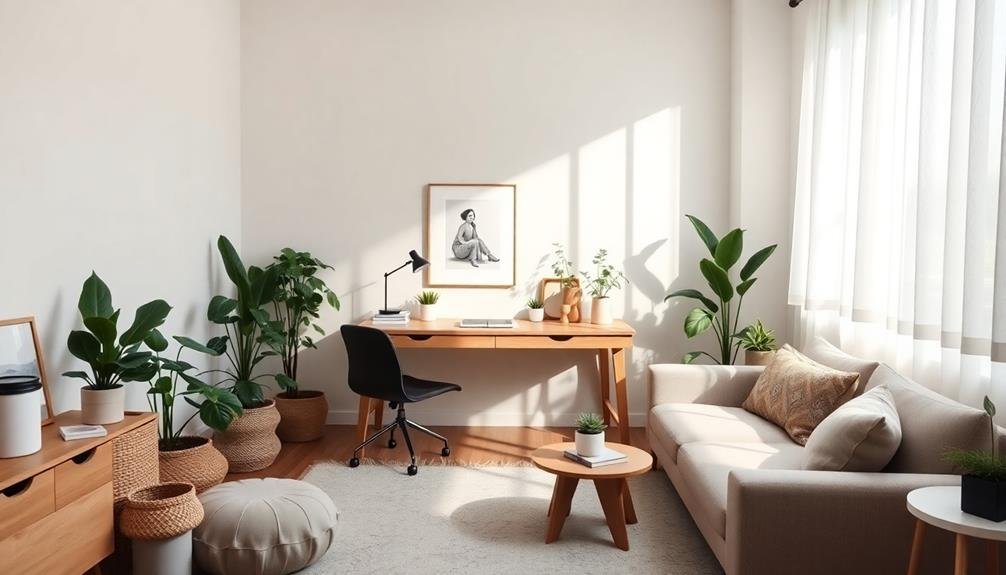To transform your home office into a stress-free zone, start by evaluating your current space and optimizing comfort. Declutter and organize using stylish storage solutions for a tidy environment. Choose calming colors like soft blues or greens to create serenity and enhance focus. Make sure to maximize natural light and supplement with adjustable task lighting for comfort. Incorporating plants not only purifies the air but adds a touch of nature, fostering creativity. Personal touches, such as photos and inspiring decor, can motivate you. Establish clear boundaries for work hours to minimize distractions and create a balanced workspace for productivity and calm. Explore further strategies to enhance your workspace.
Assess Your Current Space
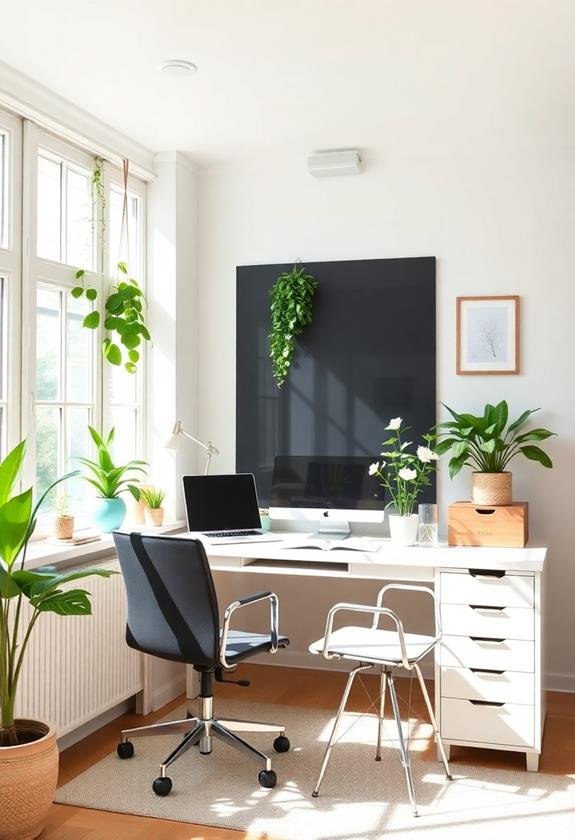
Before diving into stress relief techniques, it's essential to evaluate your current space. Take a moment to observe your home office. Notice the arrangement of your desk, the position of your chair, and the overall organization of your materials. Is your workspace cluttered, or does it feel open and inviting? A chaotic environment can contribute to stress, making it harder for you to focus on tasks that require your attention. Consider enhancing your setup with stylish decor ideas that not only elevate your aesthetic but also improve functionality.
Consider the functionality of your office. Are you comfortable in your chair? Does the lighting support your productivity, or does it strain your eyes? Even minor adjustments, like repositioning your desk to utilize natural light, can make a significant difference.
Next, think about the sounds and distractions in your space. Are there constant interruptions from outside, or is there a lack of privacy? Identifying these factors can help you create a more serene atmosphere.
Lastly, reflect on how your workspace makes you feel. Incorporating personal touches, like plants or inspiring artwork, can enhance your mood and motivation. By evaluating these elements, you lay the groundwork for a more calming, productive environment, ultimately easing your stress levels.
Choose Calming Colors
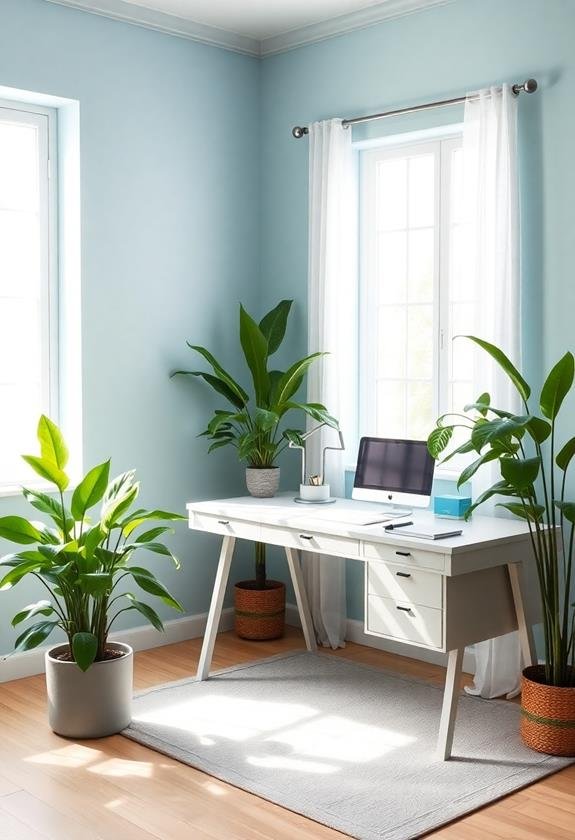
After evaluating your workspace, the next step is to contemplate the colors surrounding you. The hues in your home office can greatly influence your mood and productivity. Soft, calming colors like blues, greens, and soft grays can create a serene atmosphere, making it easier for you to concentrate and feel at ease. For instance, a light blue can evoke a sense of peace, while gentle green shades can remind you of nature, both of which help to reduce stress. Embracing a cohesive color scheme guarantees that your decor remains harmonious and visually appealing.
When choosing colors, think about how they make you feel. You might want to opt for a neutral palette with pops of color to maintain a balanced environment. For example, painting your walls a soothing beige or soft gray and adding colorful accents through artwork or office supplies can provide the perfect mix of calm and inspiration.
Additionally, consider the lighting in your space, as it can alter how colors appear. Natural light can enhance calming colors, making your office feel more inviting. By thoughtfully selecting your color scheme, you're taking an essential step towards transforming your workspace into a stress-free zone, ultimately fostering a more productive and enjoyable work environment.
Declutter and Organize
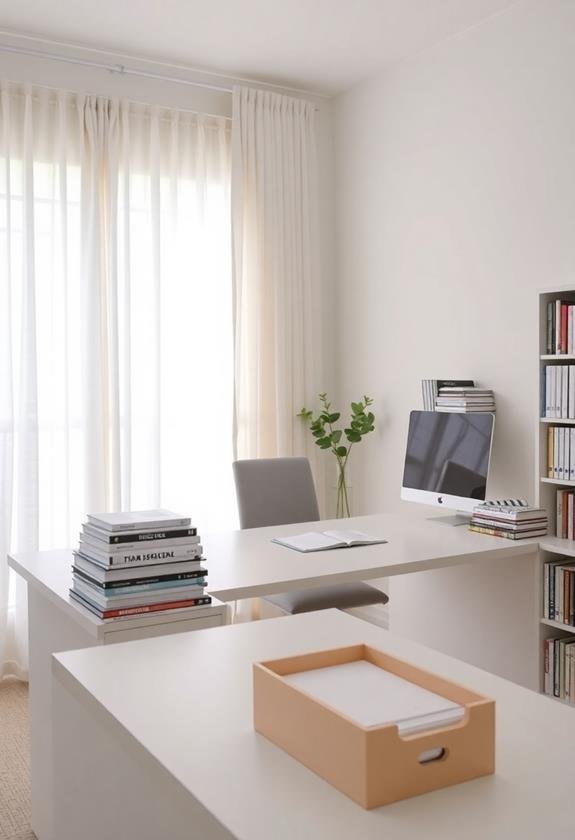
A cluttered workspace can quickly lead to a cluttered mind, making it essential to declutter and organize your home office. Start by sorting through your items. Take everything out of drawers, shelves, and your desk, and categorize them into keep, toss, and donate piles. This process not only clears space but also gives you a fresh perspective on what you truly need. Consider upgrading to a stylish home office desk that enhances both functionality and aesthetics, as it can greatly improve your workspace environment stylish home office desks.
Next, focus on storage solutions that work for you. Invest in organizers, bins, or shelves that can help you keep similar items together. For example, keep your stationery in one drawer and important documents in a filing cabinet. Labeling these containers can also save you time when searching for items later.
Optimize Lighting
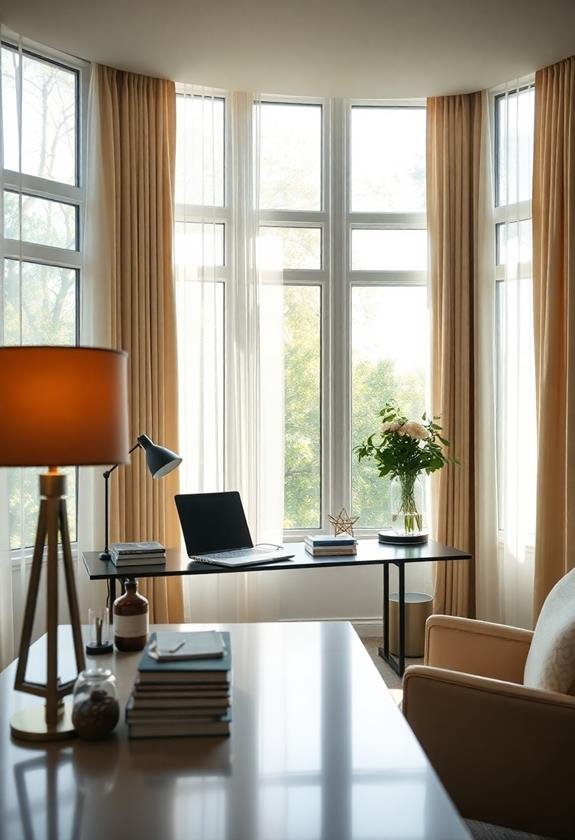
An organized workspace sets the stage for improving your overall productivity, but lighting plays a key role in creating an inviting atmosphere. Proper lighting can reduce eye strain, enhance focus, and even boost your mood. Start by maximizing natural light; position your desk near a window, allowing daylight to flood your space. It not only brightens your environment but also helps regulate your circadian rhythm, making you feel more alert during the day.
If natural light's limited, consider investing in adjustable LED desk lamps that mimic daylight. These lamps can provide ample brightness while allowing you to adjust the intensity based on your needs. Task lighting is essential; it illuminates your work area without overwhelming your senses. For general illumination, use a combination of overhead lighting and lamps, creating layers of light that can be easily adjusted.
Lastly, pay attention to the color temperature of your bulbs. Warmer tones create a cozy atmosphere, while cooler tones can enhance concentration. By thoughtfully optimizing your lighting, you'll not only create a more enjoyable workspace but also foster a productive and stress-free environment that supports your work habits.
Incorporate Nature
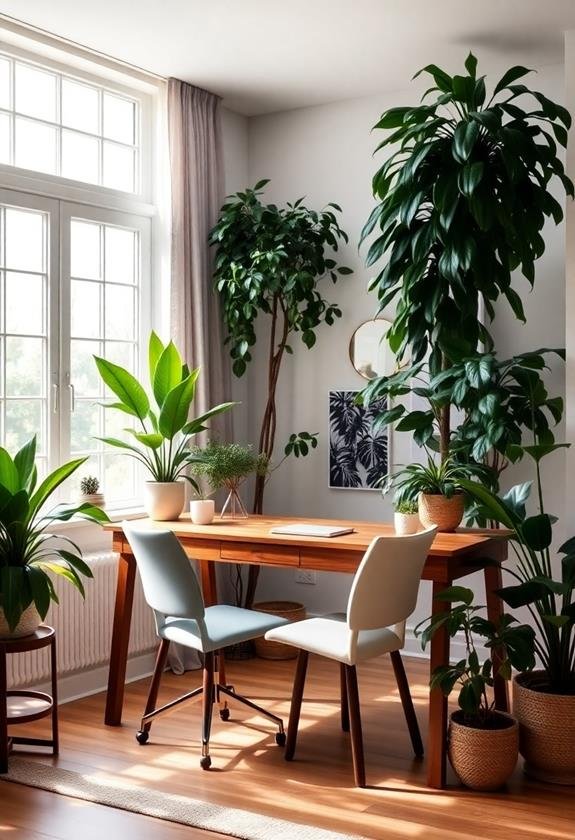
Incorporating elements of nature into your home office can noticeably enhance your well-being and productivity. Bringing the outdoors inside, whether through plants, natural light, or organic materials, creates a soothing environment conducive to focus and creativity. For instance, adding a few potted plants not only purifies the air but also adds a splash of color and life to your workspace. Studies have shown that plants can reduce stress and increase feelings of calm, helping you stay grounded during busy workdays.
You might also consider positioning your desk near a window to enjoy natural light. Sunlight boosts your mood and regulates your circadian rhythms, making it easier to maintain energy levels throughout the day. If possible, opt for a desk made of wood or bamboo, as these materials evoke a sense of warmth and connection to nature.
Lastly, incorporating natural elements like stones, shells, or even images of landscapes can create a serene atmosphere. By intentionally designing your workspace with nature in mind, you can foster a stress-free zone that promotes focus and enhances your overall work experience. Embrace nature, and watch your productivity soar!
Personalize Your Workspace
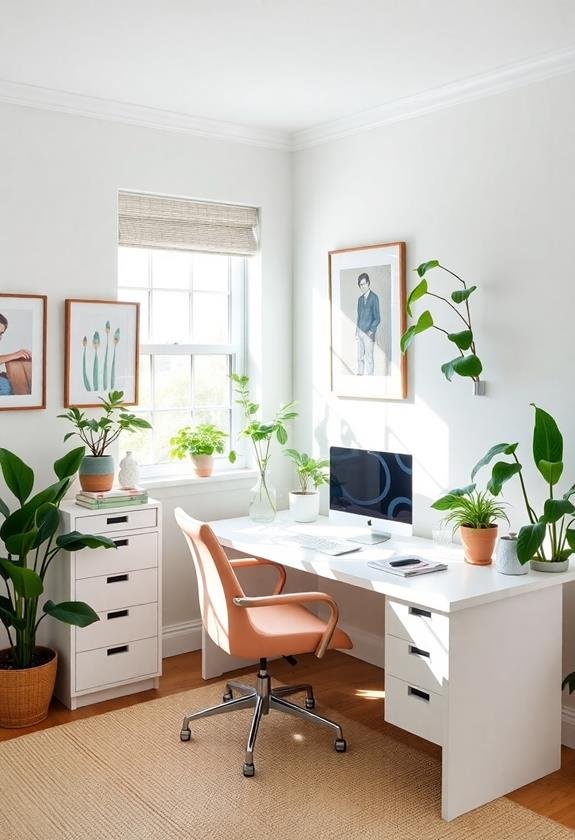
Creating a workspace that reflects your personality can greatly boost your motivation and satisfaction while working from home. Start by choosing colors that inspire you; perhaps a calming blue or a vibrant yellow, depending on your preferences. You could paint the walls, add colorful art pieces, or even use decorative items like cushions or rugs to infuse your workspace with energy.
Incorporate personal items that resonate with you, such as photographs, awards, or memorabilia from your hobbies. These elements serve as constant reminders of your achievements and passions, making your workspace feel uniquely yours. If you enjoy reading, consider adding a small bookshelf filled with your favorite titles, inviting you to take breaks and recharge.
Don't forget about functionality. Organize your desk with stylish yet practical storage solutions that reflect your style, whether it's sleek and modern or cozy and rustic. By blending aesthetics with practicality, you'll create a space that not only looks good but also supports your productivity. Finally, remember to regularly update your workspace as your interests and projects evolve, keeping the environment fresh and inspiring.
Invest in Comfort
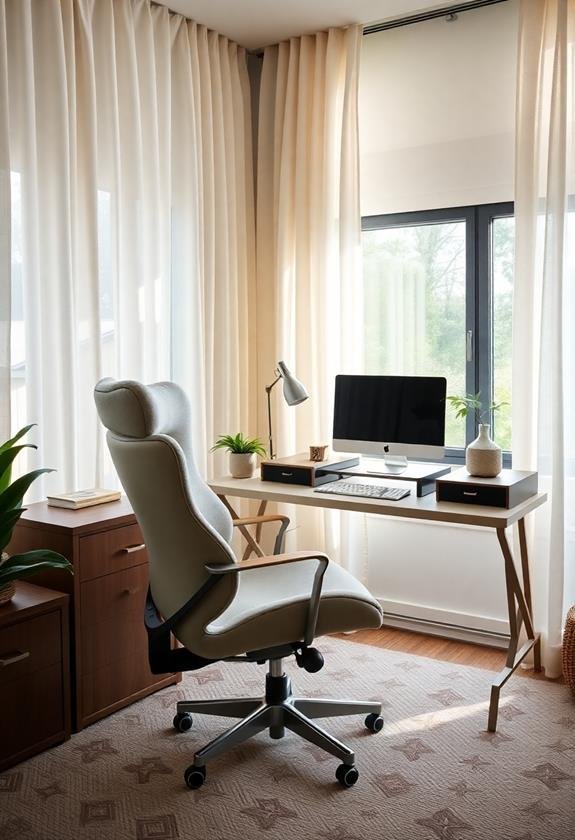
To work efficiently from home, investing in comfort is essential. A comfortable workspace considerably boosts your productivity and reduces stress. Start with an ergonomic chair that supports your back; without proper support, long hours can lead to discomfort and fatigue. Additionally, consider a desk that's adjustable. This allows you to switch between sitting and standing, promoting better posture and circulation.
Don't overlook the importance of proper lighting. Natural light is ideal, so position your desk near a window if possible. If that's not an option, invest in good-quality desk lamps that reduce eye strain and create a pleasant atmosphere.
Temperature control also plays a crucial role in comfort. Keep a fan or heater nearby to maintain your ideal working temperature, preventing distractions caused by discomfort.
Establish Boundaries
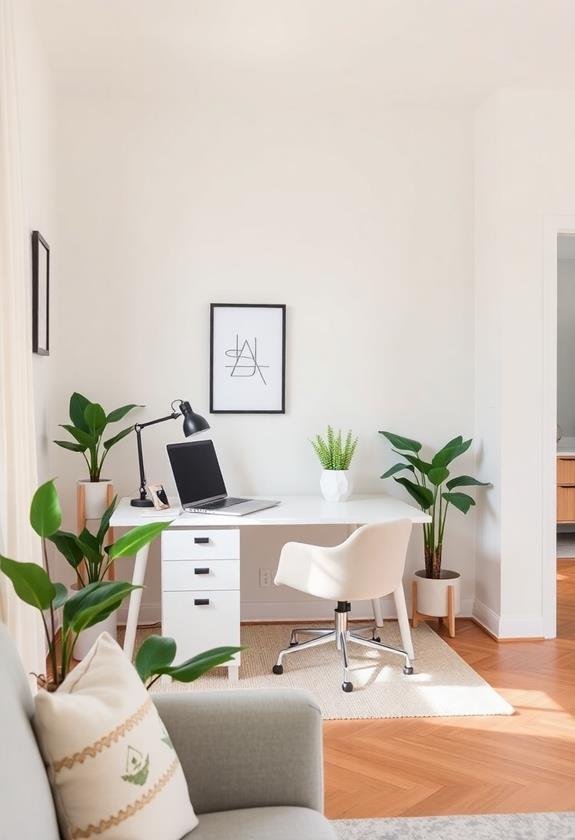
Establishing boundaries is essential for maintaining a healthy work-life balance while working from home. When your home becomes your office, it's easy to blur the lines between work and personal time. To create a stress-free zone, you need to set clear boundaries that protect your time and mental space. Here are three effective ways to do just that:
- Designate a Workspace: Choose a specific area in your home for work. This helps signal to yourself and others when you're in "work mode" and minimizes distractions.
- Set Work Hours: Determine your work hours and stick to them. Communicate these hours to your family and friends, ensuring they respect your schedule, just like they would in a traditional office.
- Take Breaks: Schedule regular breaks throughout your day. These moments allow you to recharge and prevent burnout, making it easier to focus when you're working.
Frequently Asked Questions
How Can I Reduce Noise Distractions in My Home Office?
To reduce noise distractions in your home office, start by identifying the primary sources of noise. You can use noise-canceling headphones or play soft background music to mask unwanted sounds. Consider adding rugs or curtains, which absorb sound and enhance acoustics. If possible, rearranging your workspace away from noisy areas can help, too. Finally, communicating with others in your home about your work hours can foster a quieter environment.
What Plants Are Best for Improving Air Quality in an Office?
Imagine entering a lush, green sanctuary where the air feels fresh and invigorating. In your office, consider adding plants like spider plants, peace lilies, or snake plants. These varieties not only beautify your space but also excel at purifying air by removing harmful toxins. They're low-maintenance, thrive in various light conditions, and can boost your mood, making your work environment feel more alive. Investing in these plants can enhance your overall well-being.
How Do I Maintain My Home Office's Cleanliness Long-Term?
To maintain your home office's cleanliness long-term, start by establishing a daily cleaning routine. Spend a few minutes each day organizing your desk and decluttering any unnecessary items. Invest in storage solutions, like bins or shelves, to keep supplies tidy. Additionally, schedule a weekly deep clean to address dusting and vacuuming. By consistently prioritizing cleanliness, you'll create a more productive environment that inspires focus and minimizes stress over time.
Can Aromatherapy Enhance My Focus While Working?
Imagine you're working on a big project, feeling overwhelmed. You decide to try essential oils. As you diffuse lavender, you notice your anxiety lessening, and your focus sharpening. Aromatherapy can indeed enhance your concentration. Scents like peppermint and citrus are known to invigorate the mind, helping you stay alert and productive. By incorporating these scents into your workspace, you create an environment that supports clarity and motivation, boosting your overall work performance.
What Are Effective Time Management Strategies for a Stress-Free Workday?
To manage your time effectively, start by prioritizing tasks using the Eisenhower Matrix, which helps distinguish between urgent and important. Break your day into focused work sessions, like the Pomodoro Technique, where you work for 25 minutes and take a 5-minute break. Set specific goals for each session to maintain direction. Finally, review your progress at the end of the day, adjusting your strategies as needed to improve your productivity continuously.

